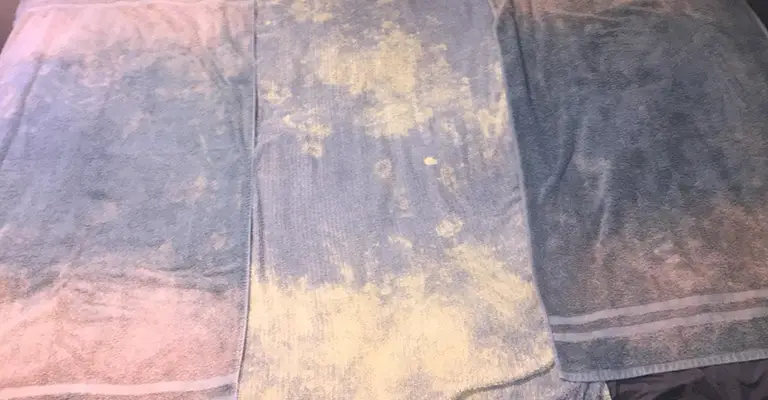When bleached, grey normally turns into pink but depending on the concentration of bleach, it may also transform into white, purple, red, or some other color.

When Bleaching Grey Fabric What Color Does It Turn
People generally use bleach on white clothes since it removes stains and whitens the clothes. It also sanitizes the clothes, killing germs and bacteria. But what about when colored clothes are bleached? Well, colored clothes react with bleach thus transforming them into a different color.
Hence you might have heard people complaining about getting pink or red stains on clothes after they were washed with bleach. Bleach, therefore, is used to change the color of fabrics, and to create new patterns or designs on clothes. However, it’s not always predictable how the bleach will react with fabric and what color it will become.
Generally, if a grey fabric is bleached for a considerable amount of time, it changes into pink. Most of the time, whether the fabric is cotton or linen, the color turns out pink. But depending on the concentration, the shade may vary. It may come out as bright pink, pale pink, or peach color. Sometimes the color ends up orange, light red, or light purple.
How Does Bleach Transform the Color of Fabrics?
Color transformation due to bleaching occurs when color-reflecting chemical compounds -chromophores present in fabric dye get their chemical bonds broken due to oxidation.
The colors we see on clothes are the visible spectrum of light reflected by chromophores. When bleach is used, an oxidation reaction occurs, initiated by the oxygen released from bleach, breaking the old chemical bonds and creating a new ones.
Afterward, the modified chromophores reflect a spectrum outside the visible range showing a different color. Sometimes it may reflect no spectrum and display the color white.
Factors that Affect Bleached Fabric
Now that we know the mechanism of color transformation, we need to consider a few factors that affect color change.
Even though the color of the dye predominantly decides what color dye will turn when bleached; the type of dye, the concentration of bleach, the type of fabric material, and the duration of bleaching also exert an influence on the process of changing color.
1. Types
The intensity of color transformation of cotton is greater than linen and rayon. For a polyblend fabric, the changed color is of two different intensities, resulting in heathered and speckled color. On the other hand, synthetics mostly don’t react. Moreover, fabrics such as wool, leather, spandex, and silk shouldn’t be bleached.
2. Concentration
The concentration and duration of bleaching are also important in the process of transforming color. The lighter the concentration of bleach is, the less intense the oxidation will be. Besides, a longer duration of bleaching will change the color more severely. Again, the same color of the fabric, but with different dye types may give different results.
However, considering all these factors a grey fabric may turn into different colors. Grey can also turn white if the dye is light enough. But it’s a tough job to whiten completely because the fabric may get damaged even before it changes into white.
No change of color
Another result of bleaching is no change of color. It sometimes happens that despite bleaching the grey clothes, the color remains the same. There are a lot of reasons it may happen. One of the reasons is the material of the fabric. Fabrics like polyester and nylon don’t change color since they don’t react with bleach.
Moreover, some clothes are chemical resistant, which means these fabrics don’t react with any chemical substances, thus preventing the reaction with bleach. Therefore, in these cases, grey fabrics remain unchanged when bleached.
Frequently Asked Questions and Answers
How much bleach should I put into the water?
You should never directly put bleach on clothes. It is a must to dilute the bleach, otherwise, the fabrics will get damaged. The advisable ratio is from 1:4 to 1:5.
How long should I keep my shirt in bleach water?
Bleach is a strong chemical. If clothes are kept in bleach too long, the fabrics will break down and get ruined. If the intention is to only clean and disinfect the clothes, 5 minutes would be enough. But to change color, it might take 20 minutes to an hour depending on the shade of color you want to achieve.
However, in case you want to stop bleaching after a certain point, you may use the neutralizer that is used to stop the bleaching reaction.
Which type of bleaching should be used on clothes?
The most common type of bleach used in households is chlorine bleach that contains sodium hypochlorite.
Another type used is oxygen bleach which contains hydrogen peroxide.
What is a “neutralizer”?
A neutralizer is used to discontinue the oxidation reaction of bleach. Neutralizer is made by mixing hydrogen peroxide into the water with a ratio of 1:10.
To conclude
It is impossible to precisely predict the exact color grey will turn into since the process of bleaching is not independent. However, changing the color and creating designs on clothes by bleaching is an interesting experiment. Even though the result may not always end up satisfying, a try-out is worth the risk.
Leave a Reply